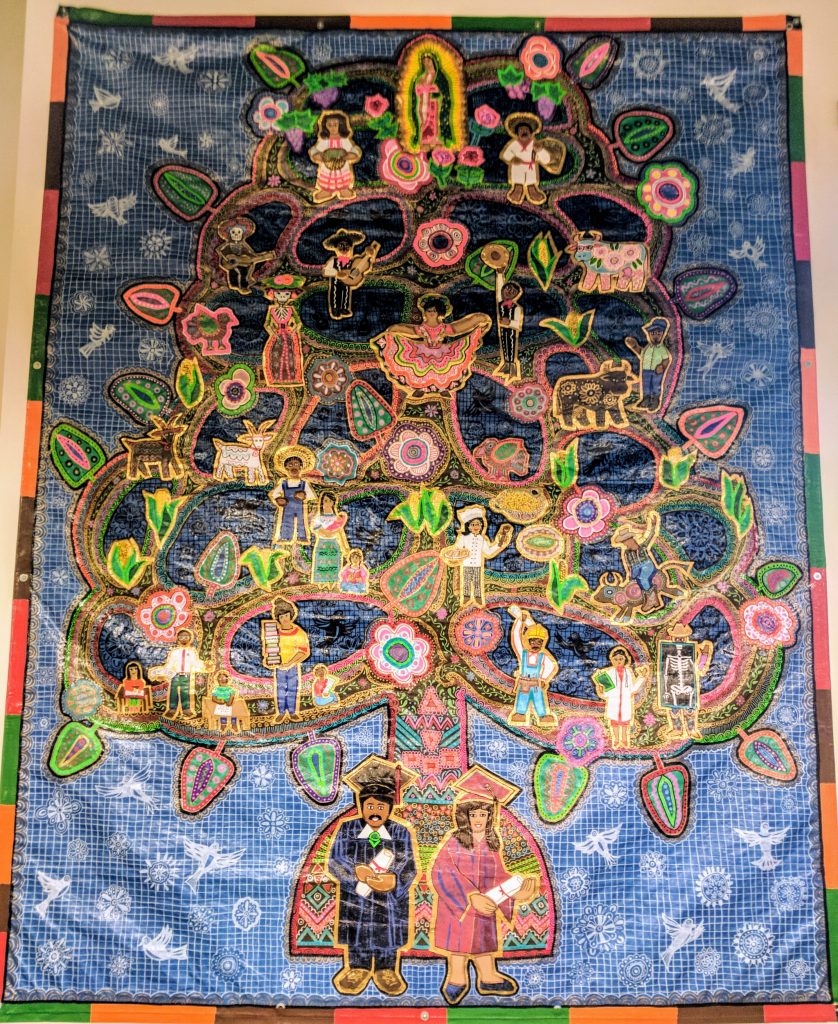“To the Canyon” by Collin Pfeifer
Spray Painted Art
This is located in the Local History Area
This project was commissioned by the Nampa Library Foundation, funded through donations, in honor of Karen Ganske, former Nampa Library Director.


Collin says, “I’ve been into creating things for as long as I can remember. As a teenager I became fascinated with graffiti art. Having little guidance, I found myself attempting to create a style that fit my personality. Over the years my approach has evolved into larger scale murals, and flavorful color palettes primarily using spray paint. I’m incredibly fortunate to have turned my passion into a full-time job, and I look forward to every creative opportunity with excitement.”
This series of panels reflect on the foundation that Nampa was built upon. My research led me to believe that the term “Nampa” derives from the Shoshone word “Namb” or “Nambuh”, which translates to “footprint” or “moccasin”. The Shoshoni people were very much in tune with nature and all the benefits it provided. Their footprints inhabited these lands and I feel that the intersections between these native people, agriculture/irrigation, and the railroad are important variables within Nampa’s developmental equation. Their connection to what is now Canyon County, set precedent for the future growth of a unique community set within Idaho’s magnificent landscape. To read the full description of each panel, click here. View a timelapse of the art and installation process here.
Photography: Mark Lisk
This is located next to the elevator

Mark Lisk has long roamed the deserts, mountains and river canyons of the American west by foot. A graduate of Brooks Institute of Photographic Arts, Mark climbs from the sea to high ridges and plains, gathering within his camera worlds of color and expanse that few ever see or capture in any form. From dry curls of patterned lake bottom to the tiniest brilliant lichen set before a vast line of granite peaks, Mark’s foregrounds set him apart. His work fits whole universes of wilderness into single frames under-glass. Mark has recently re-discovered his passion for the black and white image. His strong sense of composition, complements black and white tones giving the viewer a sense of isolation, alone in a wide sweeping landscape.
Jerri Lisk
This is located by the Community Event Board

Jerri Lisk is inspired by the dramatic landscapes encountered in her diverse travels and never leaves home without her sketchbook in hand. Back in her studio, Jerri interprets her line drawings into paintings of vibrant color which combine the unique surface of sanded aluminum and a selectively naïve style to skillfully convey the raw, yet seductive, innocence of nature. Her compositions float within a border of aluminum, having a three-dimensional feel which suggests a separate metal frame.
Mel Vincent
Located in the Local History Room

Located in the Spanish Language Section

Mel Vincent was born in Nampa in 1925, and graduated from high school there in 1943. After serving three years in the Navy Air Corps, he attended Minneapolis School of Art. Mel operated a free lance art studio in Minneapolis until 1960, then moved to California to work as an art director at Breuner’s Furniture of California. He moved to Eugene in 1962 to be advertising/art director for Rubenstein’s Furniture. Mel opened his art/photo studio in 1980. Now semi-retired, he spends his spare time painting the Oregon outdoors, primarily in watercolor.
Melissa “Sasi” Chambers
Árbol de la Vida
Tree of Life
Located in the Spanish Language Section

View the news article about this piece of art HERE.
Excerpts from the article:
Chambers is a local artist who lives in Boise and specializes in art pieces that are made by unorthodox materials like polyvinyl tarp, duct tape and oil-based markers.
After three months and 60 hours of work on the piece, her tarpage was unveiled on the third floor of the library in the Spanish-language section near the children’s books. It was paid for by a grant from Key Bank.
Chambers said her art is often inspired by other cultures. She commonly draws inspiration from African culture, but this assignment took her back to her childhood, where she briefly lived in Spain.
The emphasis of the tarpage, the Tree of Life, has roots in Mexico and was originally created to teach the Biblical story of creation. She said she thought it would mesh with the rest of the library, which follows a tree theme with its art on each floor.
Included in the tree are traditional Hispanic figures, such as the Virgin of Guadalupe and a skeletal man in reference to the Day of the Dead. Also included are figures that depict other occupations that are present in Nampa, such as a doctor, an engineer and dairy farmer. At the base of the tree are two college graduates, one in Northwest Nazarene University colors and the other in College of Western Idaho colors.
Click here to view the 1st Floor Art
Click here to view the 2nd Floor Art
